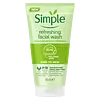What's inside
What's inside
 Key Ingredients
Key Ingredients

 Benefits
Benefits

 Concerns
Concerns

 Ingredients Side-by-side
Ingredients Side-by-side

Talc
AbrasiveZinc Stearate
Cosmetic ColorantNylon-12
Octyldodecyl Stearoyl Stearate
EmollientLauroyl Lysine
Skin ConditioningPentaerythrityl Tetraethylhexanoate
EmollientHdi/Trimethylol Hexyllactone Crosspolymer
Caprylyl Glycol
EmollientCaprylhydroxamic Acid
Glycerin
HumectantTocopheryl Acetate
AntioxidantSilica
AbrasivePtfe
CI 77163
Cosmetic ColorantIron Oxides
CI 77492
Cosmetic ColorantCI 77499
Cosmetic ColorantMica
Cosmetic ColorantTitanium Dioxide
Cosmetic ColorantUltramarines
Ricinus Communis Seed Oil
MaskingEuphorbia Cerifera Wax
Octyldodecanol
EmollientOzokerite
Emulsion StabilisingCaprylic/Capric Triglyceride
MaskingIsopropyl Myristate
EmollientMicrocrystalline Wax
Emulsion StabilisingCopernicia Cerifera Wax
Simmondsia Chinensis Seed Oil
EmollientPhenoxyethanol
PreservativeLavandula Angustifolia Oil
MaskingEthylhexylglycerin
Skin ConditioningSorbic Acid
PreservativeTocopherol
AntioxidantTalc, Zinc Stearate, Nylon-12, Octyldodecyl Stearoyl Stearate, Lauroyl Lysine, Pentaerythrityl Tetraethylhexanoate, Hdi/Trimethylol Hexyllactone Crosspolymer, Caprylyl Glycol, Caprylhydroxamic Acid, Glycerin, Tocopheryl Acetate, Silica, Ptfe, CI 77163, Iron Oxides, CI 77492, CI 77499, Mica, Titanium Dioxide, Ultramarines, Ricinus Communis Seed Oil, Euphorbia Cerifera Wax, Octyldodecanol, Ozokerite, Caprylic/Capric Triglyceride, Isopropyl Myristate, Microcrystalline Wax, Copernicia Cerifera Wax, Simmondsia Chinensis Seed Oil, Phenoxyethanol, Lavandula Angustifolia Oil, Ethylhexylglycerin, Sorbic Acid, Tocopherol
 Reviews
Reviews

Ingredients Explained
These ingredients are found in both products.
Ingredients higher up in an ingredient list are typically present in a larger amount.
Glycerin is already naturally found in your skin. It helps moisturize and protect your skin.
A study from 2016 found glycerin to be more effective as a humectant than AHAs and hyaluronic acid.
As a humectant, it helps the skin stay hydrated by pulling moisture to your skin. The low molecular weight of glycerin allows it to pull moisture into the deeper layers of your skin.
Hydrated skin improves your skin barrier; Your skin barrier helps protect against irritants and bacteria.
Glycerin has also been found to have antimicrobial and antiviral properties. Due to these properties, glycerin is often used in wound and burn treatments.
In cosmetics, glycerin is usually derived from plants such as soybean or palm. However, it can also be sourced from animals, such as tallow or animal fat.
This ingredient is organic, colorless, odorless, and non-toxic.
Glycerin is the name for this ingredient in American English. British English uses Glycerol/Glycerine.
Learn more about GlycerinPhenoxyethanol is a preservative that has germicide, antimicrobial, and aromatic properties. Studies show that phenoxyethanol can prevent microbial growth. By itself, it has a scent that is similar to that of a rose.
It's often used in formulations along with Caprylyl Glycol to preserve the shelf life of products.
Tocopheryl Acetate is AKA Vitamin E. It is an antioxidant and protects your skin from free radicals. Free radicals damage the skin by breaking down collagen.
One study found using Tocopheryl Acetate with Vitamin C decreased the number of sunburned cells.
Tocopheryl Acetate is commonly found in both skincare and dietary supplements.
Learn more about Tocopheryl Acetate